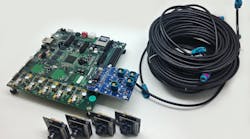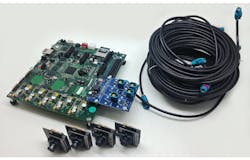Along with an industry-wide commitment to increasing the efficiency of automobiles, the promise of autonomous transport is closer to being realised. Systems that provide greater control over every element of an automobile not only offer better mileage, they also deliver greater safety. Indeed, the dream of a self-driving car is no longer science fiction. Trends such as advanced driver assistance systems (ADAS) have seen the adoption of adaptive cruise control, parking assistance, blindspot detection, and lane departure warnings.
The integration of such systems is now commonplace in luxury and high-end models, but their deployment has been less widespread in mainstream vehicles, predominantly due to cost. It’s more usual to see one or two systems taken as options in mid-range purchases, where systems such as reversing sensors or cameras add enough value to warrant any additional cost. Ideally, manufacturers would like to offer all systems at a price that is attractive to all buyers, something that really relies on adoption in higher volumes.
This file type includes high resolution graphics and schematics when applicable.
Part of the problem is the relatively bespoke nature of each system. ADAS is still an emerging technology. Therefore, each system requires a significant amount of engineering effort, even within the same model family. To reduce the R&D burden and therefore reduce ADAS costs, automakers are researching the viability of ADAS platforms that can be more easily configured and modified for different levels of functionality while meeting lower pricepoints.
The Platform Approach
A single platform that can offer extended and configurable functionality has been almost as elusive as the self-driving car. But just as the advent of ADAS is making autonomous vehicles a reality, the development of all-programmable system-on-chip (SoC) solutions has introduced a new era in system design.
For many years, FPGAs have enabled OEMs to create bespoke hardware devices at a fraction of the cost of full ASIC design. The extremely low non-recurring engineering (NRE) costs associated with FPGA development are one of its greatest advantages. In applications that exhibit very high volumes with no variation in specification, an ASIC can still represent the most compelling business and engineering option.
However, that kind of application is increasingly rare. Increasingly often, some level of configurability is required. In such cases, it is more common to choose a discrete solution based on general-purpose components such as DSPs and microcontrollers. While this option offers the most flexibility, it comes at the expense of an increased bill of materials (BoM), greater board space, and higher system power, all of which conspire to raise the overall system cost.
Ideally, OEMs looking to develop a solution that offers enough performance and flexibility for a range of configurations would target a single platform that offers the performance of hardware-based functions, the flexibility of a software-based processor, and the low NRE costs of an FPGA. The Zynq All Programmable SoC from Xilinx offers this combination of features. Featuring dual ARM Cortex-A9 processors and tightly coupled programmable logic in a fully integrated device tested to AEC-Q1000 and beyond, it is suitable for developing ADAS solutions.
The A9 cores can be used together or independently to run anything from bare-metal software up to real-time operating systems, allowing simple control algorithms to run alongside complex video analytics software. For maximum performance, functions can be accelerated in dedicated hardware blocks configured in the programmable logic fabric and tightly coupled to the processors.
With a virtually unlimited level of parallel processing on offer, DSP blocks can be deployed to tackle complex algorithms much more efficiently than in software alone. The level of integration allows engineers to partition any design with the right balance between hardware acceleration and software execution.
Vision System Solution
With legislation already announced in the United States that will make rear-view cameras mandatory on all new models, multiple camera-based vision systems will feature significantly in ADAS as a market segment for automakers.
Meeting the processing demands of vision systems is challenging. Complex algorithms are used to identify and detect objects that are moving relatively to the point of view, often at high speeds. The required processing power is difficult to estimate, as the algorithms used to provide better detection are constantly evolving.
Developers frequently face this kind of design risk: developing software for a hardware platform that may not be available until the end of the project timeline. This approach is understandable as hardware is constantly being improved and many devices have a publicly available roadmap, allowing developers to target a device long before it becomes commercially available.
The risks associated with this approach, however, are also clear. There is no guarantee that the device or devices will become available or meet the expected specifications in line with the project timeline.
The automotive-qualified XA Zynq is available today to help developers get the most from it. Together with Embedded Vision Systems (eVS) and Digital Design Corporation (DDC), Xylon has developed the logiADAK-Zynq-7000 ADAS development platform. This reference design allows developers to focus on developing ADAS solutions targeting this flexible automotive-qualified SoC (Fig. 1).
The logiADAK-Zynq-7000 provides a platform for the integration of hardware- and software-based intellectual property (IP) to create ADAS that can feature up to six 1-Mpixel camera video streams running at 30 frames/s. The kit also includes application-specific software for the evaluation and demonstration of ADAS solutions.
This software may include 3D 360° surround view and 2D “bird’s eye” view, using up to six cameras simultaneously; rear-view cameras employing selectable viewing modes and pedestrian detection and range estimation with graphic overlays; forward-looking cameras with pedestrian and vehicle detection; lane departure warning; and, blindspot detection with optical flow.
Hardware for Software Development
Engineering teams often can find themselves divided between hardware and software development because the disciplines are quite different. Normally, though, software development progresses before the hardware is available. As mentioned earlier, this has inherent risks.
By using a platform such as the logiADAK, this scenario changes. The hardware is ready and available from day one, and it even can be configured generically to allow instant access to the ARM Cortex-A9 MPCore processing subsystem. As the project progresses, more of the functionality can be ported to the programmable logic fabric to accelerate performance. Using the All Programmable SoC approach makes changing the hardware/software partition much simpler (Fig. 2).
For example, intensive pixel-level processing may exceed the performance of the A9 core or cores. Using a profiler, the specific software processes that are consuming the most processing bandwidth can be identified and moved to the programmable fabric as hardware accelerated IP blocks.
The same approach also ensures that the A9 cores are fully utilised, moving any hardware-based functions to be executed in the available processor bandwidth and thereby allowing the smallest and most cost-effective SoC to be used in any given application.
Summary
Software development is now considered the most challenging part of system design. Providing a flexible and configurable hardware platform earlier on in the development cycle makes both software and hardware development less challenging while improving the overall system design.
By targeting an All Programmable SoC for ADAS development, OEMs can reduce their risk and timescales, secure in the knowledge that the hardware platform is flexible and powerful enough to accommodate almost any design.
As driver assistance solutions proliferate, automakers will seek new ways to exploit technology to make cars smarter, safer, and more efficient. Reducing the design burden and cost will be an increasingly important element in the evolution of ADAS.
The logiADAK Zynq-7000 Automotive Driver Assistance Kit can significantly help developers of camera-based driver assistance systems to accelerate their design cycle and ultimately be even more innovative.
Stephan Janouch is the senior manager of automotive marketing EMEA for Xilinx. He has more than 15 years of experience in the automotive industry. Previously, he worked as a (field) applications engineer, editor in chief, and regional sales manager. He has a Dipl.-Ing.(FH) in electrical engineering from the University of Applied Sciences, Landshut, Germany.



